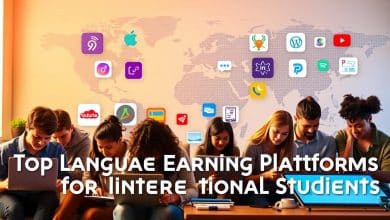Top Study Tools Every International Student Should Know
Navigating academic life abroad brings distinct challenges, from language barriers to unfamiliar teaching methods. The global AI education market, valued at $2.5 billion in 2022, reflects how technology reshapes learning. Experts predict it will soar to $88.2 billion by 2032, growing at 43.3% annually. This surge highlights a critical shift: digital platforms now serve as lifelines for those adapting to new educational systems.
Artificial intelligence tools have become indispensable in addressing cross-cultural academic hurdles. They streamline complex tasks like translating course materials or organizing research data. Over 60% of learners in competitive universities now use these resources to manage coursework efficiently. Such adoption isn’t surprising—these solutions often boost retention rates by 30% while helping users master time management.
Cultural differences and varying teaching styles no longer need to hinder progress. Modern applications offer personalized support, from interactive quizzes to real-time collaboration features. Institutions worldwide increasingly integrate these innovations, recognizing their power to level the academic playing field. For learners abroad, choosing the right platforms can mean the difference between struggling and thriving.
This guide explores cutting-edge resources designed to empower global scholars. It focuses on practical, research-backed options that simplify complex concepts and foster confidence. Whether mastering a new language or tackling advanced coursework, the right digital allies make success achievable.
Overview of Student Study Tools for International Success
Global education demands resources that transcend traditional classroom boundaries. Digital platforms now blend artificial intelligence with adaptive design, creating tailored solutions for diverse academic needs. These innovations address everything from language adaptation to collaborative projects across time zones.
Defining Modern Study Tools
Today’s educational resources leverage cloud technology and interactive designs. Unlike static textbooks, they offer dynamic formats like AI-generated quizzes and multimedia flashcards. Real-time editing features allow groups to co-create presentations from different continents.
| Traditional Methods | Modern Solutions | Key Advantage |
|---|---|---|
| Printed materials | Interactive trivia games | Engagement boost |
| Manual note-taking | Smart summarization apps | Time efficiency |
| Fixed schedules | Adaptive learning paths | Personalized pacing |
Benefits for Global Learners
Multilingual interfaces and cultural context filters help users grasp foreign concepts faster. One platform might adjust examples to reflect local histories while maintaining core academic standards. Progress dashboards highlight areas needing attention, reducing overwhelm in fast-paced courses.
Accessibility remains central to these systems. Voice-to-text converters and adjustable font sizes ensure equitable access. As one academic advisor noted, “These tools don’t just translate words—they translate understanding.”
The Importance of Efficient Study Tools in Today’s Academic Environment
Academic success in foreign institutions demands more than just intelligence—it requires strategic resource management. Learners navigating cross-border education face layered obstacles, from decoding unfamiliar formats to synchronizing schedules across continents. The right solutions transform these hurdles into manageable tasks.
Academic Challenges Faced by International Learners
Language gaps complicate even basic tasks. Imagine analyzing Shakespeare while translating idioms. Time zone differences add pressure—submitting assignments at 3 AM local time isn’t sustainable. Cultural nuances in grading rubrics or classroom debates often leave individuals guessing what “participation” truly means.
One engineering major shared: “I spent hours formatting citations correctly, only to lose marks for missing cultural references.” Such stories highlight why adaptable resources matter.
How Technology Enhances Learning
Digital platforms dissolve geographical barriers. Translation extensions decode complex texts instantly. Cloud-based calendars auto-adjust deadlines across time zones. AI tutors identify knowledge gaps through practice tests, offering tailored explanations.
Interactive simulations demonstrate physics principles through virtual experiments. Progress dashboards track improvement weekly, shifting focus from grades to growth. As one professor noted: “These systems don’t replace teaching—they amplify it.”
Product Roundup: Best Student Study Tools
Selecting the right academic resources requires careful evaluation of multiple factors that impact real-world effectiveness. Leading platforms combine innovative technology with user-centric designs, but quality varies significantly across options.
Criteria for Selecting Top Study Tools
High-performing solutions prioritize intuitive navigation over flashy interfaces. Cross-platform compatibility ranks as essential—learners shouldn’t lose functionality when switching devices. Customization proves equally vital, allowing adjustments for language preferences and cultural contexts.
G2 Grid Reports highlight platforms excelling in technical reliability and learning outcomes. One project manager noted: “The best systems feel invisible—they support without distracting.” Accessibility features like voice commands and adjustable layouts ensure equitable access across diverse needs.
Evaluating Features and Usability
Real-world testing reveals which features deliver results. Spaced repetition algorithms and collaborative workspaces outperform basic flashcard apps. Verified reviews emphasize responsive support teams and regular updates as key satisfaction drivers.
Analytics dashboards transform raw data into actionable insights. A biochemistry major shared: “Seeing my progress trends helped me allocate time better than any syllabus.” Premium options justify costs through AI-generated practice tests and adaptive learning paths validated by educational researchers.
Interactive Learning Tools: Kahoot! and Mentimeter
Digital platforms are reshaping how global learners interact with academic content. Two standout options combine playful engagement with practical functionality, addressing participation gaps in multicultural settings. These solutions bridge communication divides while making knowledge retention more dynamic.
Gamification for Active Participation
Kahoot! turns quizzes into lively competitions through timed trivia and music-driven challenges. Its color-coded interface lets participants answer via smartphones, with instant scoring visible to all. Instructors report higher attendance in sessions using this method. “The energy shifts completely when learners see their names on the leaderboard,” notes a language professor from UCLA.
| Feature | Kahoot! | Mentimeter |
|---|---|---|
| Best Use Case | Group quizzes | Live presentations |
| Engagement Type | Competitive games | Collaborative feedback |
| Performance Consideration | Optimal under 50 users | Handles 200+ participants |
Real-Time Collaboration Made Simple
Mentimeter transforms static lectures into two-way conversations. Presenters embed polls directly into slides, collecting anonymous responses during talks. Word clouds visualize collective ideas, while Q&A features let shy individuals contribute comfortably. Pre-built templates save hours when adapting materials across cultures.
Both platforms sync with common classroom software, though internet stability remains crucial. When connectivity falters, having backup activities ensures sessions stay productive. Regular updates address these technical demands while expanding creative options.
Smart Flashcards and Spaced Repetition: Brainscape and Quizlet
Memory mastery transforms when science meets digital innovation. Brainscape and Quizlet lead this evolution through adaptive algorithms that optimize knowledge retention across diverse academic needs. These platforms turn static information into dynamic learning experiences.
How Spaced Repetition Improves Retention
Both systems use timing algorithms rooted in cognitive psychology. Difficult concepts reappear more frequently, while familiar material fades into the background. Brainscape adds a self-assessment layer—users rate confidence levels after each flashcard session.
This dual approach creates personalized review schedules. A medical major shared: “I stopped wasting time on stuff I already knew. The system pushed me to focus on weak areas.” Data shows users retain information 2.5x longer compared to traditional methods.
Flexibility in Self-Paced Study Options
Cross-device synchronization lets learners pick up where they left off—phone reviews during commutes transition seamlessly to laptop sessions. Pre-built libraries cover 300+ subjects, from Mandarin vocabulary to quantum physics diagrams.
- Customizable intervals adapt to individual schedules
- Audio-visual formats support multiple learning styles
- Progress dashboards highlight knowledge gaps visually
Quizlet’s match games and Brainscape’s bite-sized lessons accommodate varied cultural educational backgrounds. Both platforms integrate with popular note-taking apps, turning lecture materials into interactive sessions within minutes.
User Experience and AI-Driven Features in Study Tools
Artificial intelligence reshapes how learners interact with academic material through intuitive systems that anticipate needs. These innovations transform dense textbooks into manageable insights while maintaining cultural relevance.
Integrating AI to Summarize and Organize Content
Advanced algorithms now condense 50-page chapters into bullet-point summaries while preserving core concepts. Natural language processing identifies patterns across lecture notes, creating visual mind maps automatically. One user noted: “It’s like having a personal librarian who knows exactly what I need to review.”
Language barriers diminish as systems highlight context-specific terminology. A biology major shared: “The AI translated technical terms into my native language without losing scientific accuracy.” These features prove vital when handling complex subjects across cultural frameworks.
User Insights from Real-Time Reviews
Platforms like G2 showcase authentic feedback about feature effectiveness. Recent analysis reveals:
| Feature | Satisfaction Rate | Common Praise |
|---|---|---|
| Auto-flashcards | 89% | Saves 4+ hours weekly |
| Progress analytics | 93% | Identifies weak areas |
| Multilingual support | 81% | Cultural adaptation |
Review trends highlight demand for customizable interfaces. Many praise applications that adjust text sizes and contrast ratios based on ambient lighting. As one computer science learner stated: “The system learns how I learn.”
Comparing Study Tool Features, Usability, and Accessibility
The true test of academic software lies in its ability to bridge technological and cultural divides. Leading platforms now prioritize adaptability, offering personalized experiences that maintain core functionality across devices and learning styles.
Tailoring Technology to Diverse Needs
Top-tier systems let users modify interface colors, content layouts, and notification settings. This flexibility proves crucial when switching between collaborative projects and solo review sessions. One app might offer dark mode for late-night work while another provides dyslexia-friendly fonts.
Cross-device performance remains non-negotiable. Reliable platforms sync progress instantly across smartphones, tablets, and laptops. Cloud backups ensure materials stay accessible during travel or device changes—a common reality for global learners.
Accessibility extends beyond screen readers. Keyboard shortcuts and voice commands empower users with mobility challenges. Adjustable timers help maintain focus without rigid schedules, accommodating varied productivity rhythms.
Cost structures reveal hidden advantages. Some free versions include premium collaboration tools, while paid subscriptions might offer unlimited AI analysis. As one user noted: “The right combination feels like it’s working with me, not against me.”
FAQ
What features make a learning tool effective for multilingual users?
How do AI-driven platforms improve knowledge retention?
Are gamified platforms suitable for advanced academic work?
What criteria should guide selection of digital resources?
Can flashcard apps replace traditional revision methods?
How do collaborative features enhance productivity?
Which metrics indicate a platform’s usability for beginners?
Do free versions of premium applications limit functionality?
Published on: 19 de August de 2025







